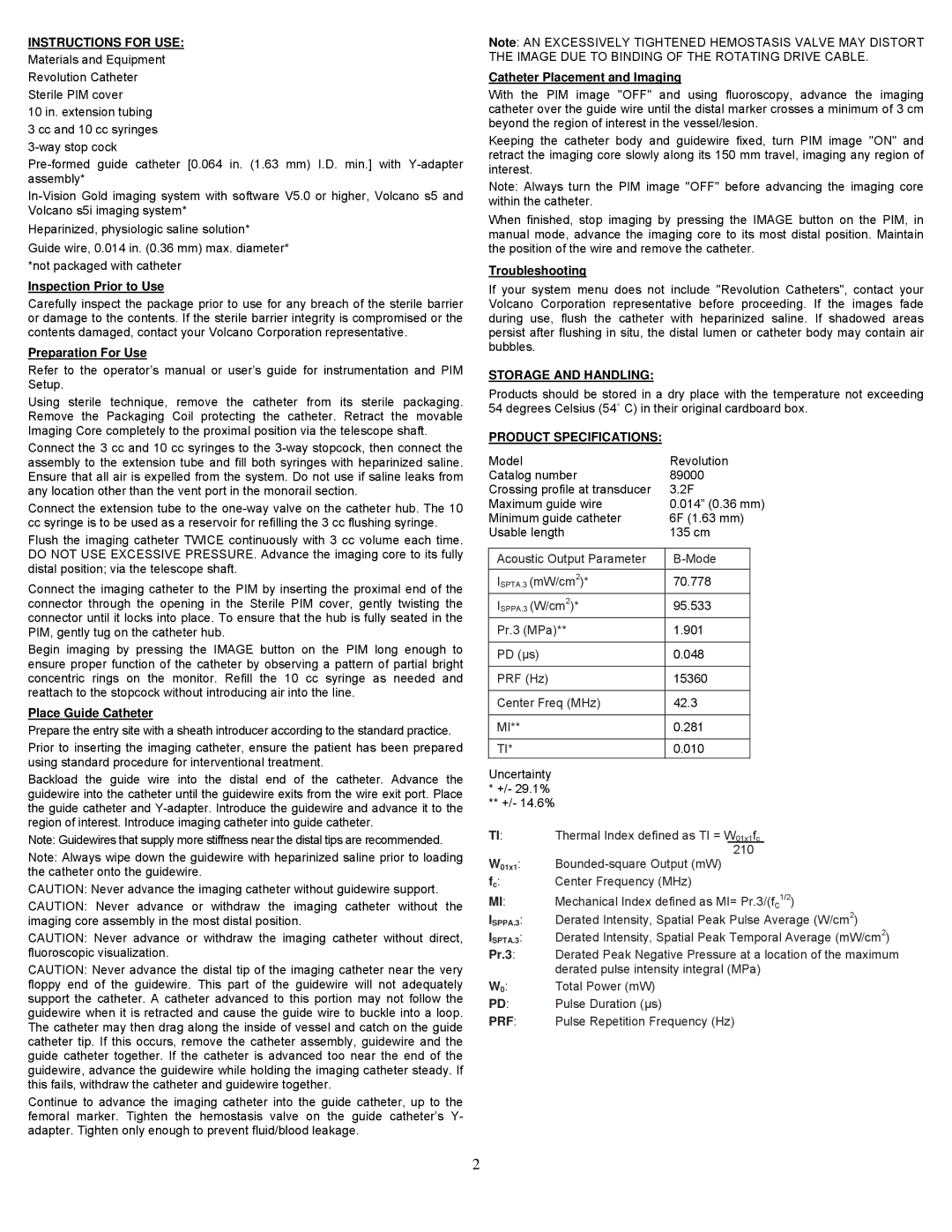INSTRUCTIONS FOR USE:
Materials and Equipment Revolution Catheter Sterile PIM cover
10 in. extension tubing
3 cc and 10 cc syringes
Heparinized, physiologic saline solution* Guide wire, 0.014 in. (0.36 mm) max. diameter* *not packaged with catheter
Inspection Prior to Use
Carefully inspect the package prior to use for any breach of the sterile barrier or damage to the contents. If the sterile barrier integrity is compromised or the contents damaged, contact your Volcano Corporation representative.
Preparation For Use
Refer to the operator’s manual or user’s guide for instrumentation and PIM Setup.
Using sterile technique, remove the catheter from its sterile packaging. Remove the Packaging Coil protecting the catheter. Retract the movable Imaging Core completely to the proximal position via the telescope shaft.
Connect the 3 cc and 10 cc syringes to the
Connect the extension tube to the
Flush the imaging catheter TWICE continuously with 3 cc volume each time. DO NOT USE EXCESSIVE PRESSURE. Advance the imaging core to its fully distal position; via the telescope shaft.
Connect the imaging catheter to the PIM by inserting the proximal end of the connector through the opening in the Sterile PIM cover, gently twisting the connector until it locks into place. To ensure that the hub is fully seated in the PIM, gently tug on the catheter hub.
Begin imaging by pressing the IMAGE button on the PIM long enough to ensure proper function of the catheter by observing a pattern of partial bright concentric rings on the monitor. Refill the 10 cc syringe as needed and reattach to the stopcock without introducing air into the line.
Place Guide Catheter
Prepare the entry site with a sheath introducer according to the standard practice.
Prior to inserting the imaging catheter, ensure the patient has been prepared using standard procedure for interventional treatment.
Backload the guide wire into the distal end of the catheter. Advance the guidewire into the catheter until the guidewire exits from the wire exit port. Place the guide catheter and
Note: Guidewires that supply more stiffness near the distal tips are recommended.
Note: Always wipe down the guidewire with heparinized saline prior to loading the catheter onto the guidewire.
CAUTION: Never advance the imaging catheter without guidewire support.
CAUTION: Never advance or withdraw the imaging catheter without the imaging core assembly in the most distal position.
CAUTION: Never advance or withdraw the imaging catheter without direct, fluoroscopic visualization.
CAUTION: Never advance the distal tip of the imaging catheter near the very floppy end of the guidewire. This part of the guidewire will not adequately support the catheter. A catheter advanced to this portion may not follow the guidewire when it is retracted and cause the guide wire to buckle into a loop. The catheter may then drag along the inside of vessel and catch on the guide catheter tip. If this occurs, remove the catheter assembly, guidewire and the guide catheter together. If the catheter is advanced too near the end of the guidewire, advance the guidewire while holding the imaging catheter steady. If this fails, withdraw the catheter and guidewire together.
Continue to advance the imaging catheter into the guide catheter, up to the femoral marker. Tighten the hemostasis valve on the guide catheter’s Y- adapter. Tighten only enough to prevent fluid/blood leakage.
Note: AN EXCESSIVELY TIGHTENED HEMOSTASIS VALVE MAY DISTORT THE IMAGE DUE TO BINDING OF THE ROTATING DRIVE CABLE.
Catheter Placement and Imaging
With the PIM image "OFF" and using fluoroscopy, advance the imaging catheter over the guide wire until the distal marker crosses a minimum of 3 cm beyond the region of interest in the vessel/lesion.
Keeping the catheter body and guidewire fixed, turn PIM image "ON" and retract the imaging core slowly along its 150 mm travel, imaging any region of interest.
Note: Always turn the PIM image "OFF" before advancing the imaging core within the catheter.
When finished, stop imaging by pressing the IMAGE button on the PIM, in manual mode, advance the imaging core to its most distal position. Maintain the position of the wire and remove the catheter.
Troubleshooting
If your system menu does not include "Revolution Catheters", contact your Volcano Corporation representative before proceeding. If the images fade during use, flush the catheter with heparinized saline. If shadowed areas persist after flushing in situ, the distal lumen or catheter body may contain air bubbles.
STORAGE AND HANDLING:
Products should be stored in a dry place with the temperature not exceeding 54 degrees Celsius (54˚ C) in their original cardboard box.
PRODUCT SPECIFICATIONS: |
|
|
Model | Revolution | |
Catalog number | 89000 |
|
Crossing profile at transducer | 3.2F | |
Maximum guide wire | 0.014” (0.36 mm) | |
Minimum guide catheter | 6F (1.63 mm) | |
Usable length | 135 cm | |
|
|
|
Acoustic Output Parameter |
| |
|
|
|
ISPTA.3 (mW/cm2)* | 70.778 |
|
ISPPA.3 (W/cm2)* | 95.533 |
|
Pr.3 (MPa)** | 1.901 |
|
|
|
|
PD (μs) | 0.048 |
|
|
|
|
PRF (Hz) | 15360 |
|
|
|
|
Center Freq (MHz) | 42.3 |
|
|
|
|
MI** | 0.281 |
|
|
|
|
TI* | 0.010 |
|
Uncertainty
*+/- 29.1%
**+/- 14.6%
TI: Thermal Index defined as TI = W01x1fc
210
W01x1:
fc: Center Frequency (MHz)
MI: Mechanical Index defined as MI= Pr.3/(fc1/2)
ISPPA.3: Derated Intensity, Spatial Peak Pulse Average (W/cm2)
ISPTA.3: Derated Intensity, Spatial Peak Temporal Average (mW/cm2)
Pr.3: Derated Peak Negative Pressure at a location of the maximum derated pulse intensity integral (MPa)
W0: Total Power (mW)
PD: Pulse Duration (μs)
PRF: Pulse Repetition Frequency (Hz)
2
